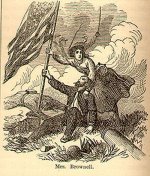Lo1863
Sergeant First Class
- Joined
- Jun 7, 2012
- Messages
- 1,071
I have reposted this in this thread because I think it will fit in better here instead of under "General Matte."
Over the years of going to different museums and looking at pictures of the different Battle Flags of the Confederacy, I have made an observation. First off, I know there was no "right" way to make flags back then and all were different so please don't jump onto me about that. Anyway it seems to me that the stars on most of the battle flags were not spaced out to cover the entire blue cross of Saint Andrew's. Observe a few examples below:
1. 13th Alabama http://www.archives.alabama.gov/refe...gs/029030.html
2. 6th Alabama http://www.archives.alabama.gov/referenc/flags/024.html
3. 10th Virginia http://www.antiquetrader.com/antique...storic_auction
4. 22nd North Carolina http://22nccompanyb.org/
5. 49th Georgia http://www.flickr.com/photos/jstephenconn/3879420779/
Now these are just a few examples I have posted here as there are MANY that can be found. So, what does this have to do with toy soldiers? Well it seems to me that many producers of ACW have overlooked this aspect with their figures when it comes to flags. I am not trying to put in any plugs but the only one that I can see that has got it right with the spacing of the stars has been First Legion (13th AL and 55th NC). Flags are one of the first things I notice as a collector and a civil war buff. This lack of attention (for lack of a better word) has also been seen in many of the reenacting units as well. Do a simple search and you will see most of the flags produced today have the stars spaced to cover the entire blue area.
I was just wondering if anyone else has noticed this and wanted to open up a FRIENDLY discussion among my fellow ACW nuts. So...have at it!
Over the years of going to different museums and looking at pictures of the different Battle Flags of the Confederacy, I have made an observation. First off, I know there was no "right" way to make flags back then and all were different so please don't jump onto me about that. Anyway it seems to me that the stars on most of the battle flags were not spaced out to cover the entire blue cross of Saint Andrew's. Observe a few examples below:
1. 13th Alabama http://www.archives.alabama.gov/refe...gs/029030.html
2. 6th Alabama http://www.archives.alabama.gov/referenc/flags/024.html
3. 10th Virginia http://www.antiquetrader.com/antique...storic_auction
4. 22nd North Carolina http://22nccompanyb.org/
5. 49th Georgia http://www.flickr.com/photos/jstephenconn/3879420779/
Now these are just a few examples I have posted here as there are MANY that can be found. So, what does this have to do with toy soldiers? Well it seems to me that many producers of ACW have overlooked this aspect with their figures when it comes to flags. I am not trying to put in any plugs but the only one that I can see that has got it right with the spacing of the stars has been First Legion (13th AL and 55th NC). Flags are one of the first things I notice as a collector and a civil war buff. This lack of attention (for lack of a better word) has also been seen in many of the reenacting units as well. Do a simple search and you will see most of the flags produced today have the stars spaced to cover the entire blue area.
I was just wondering if anyone else has noticed this and wanted to open up a FRIENDLY discussion among my fellow ACW nuts. So...have at it!


